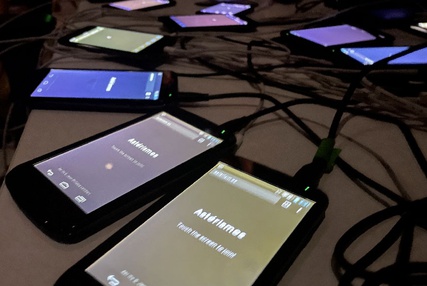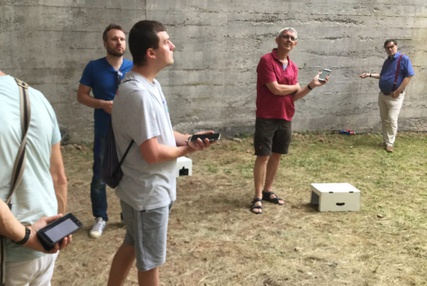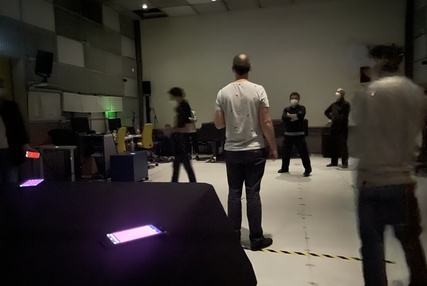Au fil de la résidence en recherche artistique qu’elle porte avec le chercheur Jean-Philippe Lambert sur Astérismes, dispositif de diffusion sonore distribuée, la compositrice Aki Ito y a déjà consacré quelques pièces – qui servent à la fois aux expériences du duo et à l’élaboration d’un nouveau langage musical intrinsèquement lié à cette lutherie en devenir. Comme souvent dans le domaine de la recherche artistique, les développements artistiques et scientifiques avancent main dans la main, se nourrissant les uns les autres – avec leurs contraintes afférentes, sources de créativité.
Latence, mère de tous les vices
Parmi les contraintes techniques du dispositif Astérismes, il en est une dont le duo soupçonnait l’existence bien avant de se lancer dans leurs recherches proprement dites : la latence. La latence, c’est le délai entre l’ordre de diffuser un son, donné à un terminal par le musicien/compositeur, et sa diffusion effective par le terminal en question. Connaître la latence est essentiel, surtout dans le contexte d’une écriture musicale : comment coordonner un discours si on ne connaît pas les délais de réaction de chaque voix ?
La latence est une somme de plusieurs fragments de temps, dont certains sont plus facilement maîtrisables que d’autres. La comparaison la plus simple est celle de l’orchestre : dans un orchestre, tous les musiciens peuvent voir le chef de manière directe et immédiate. Grâce à sa battue, le chef coordonne les événements. Imaginons à présent que chaque musicien ne puisse voir le chef que via un écran, et que le délai de diffusion de l’image soit différent pour chacun : ce serait une cacophonie.
Dans le cas d’un ensemble de téléphones portables, le rôle du chef revient à synchroniser les horloges de tous les portables en jeu. Car chaque terminal a son horloge, mais celle-ci n’est pas toujours parfaitement à l’heure : certaines vont trop vite, d’autres trop lentement. Par chance, Jean-Philippe Lambert s’était déjà attelé à ce problème dans le cadre d’un précédent projet à l’Ircam, CoSiMa, et avait élaboré plusieurs stratégies pour le solutionner – inspirées de la manière dont nos terminaux se synchronisent déjà, au quotidien, avec une horloge atomique en ligne. Ouf.
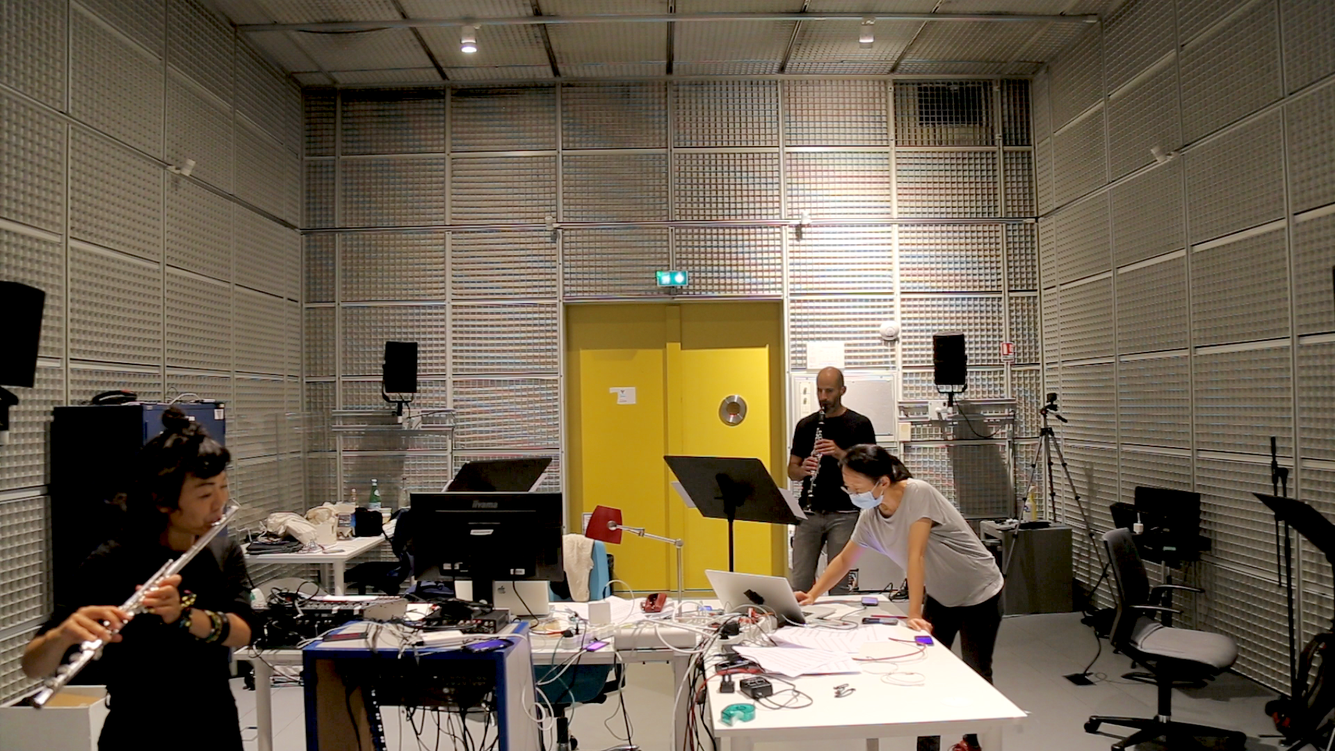
L'équipe du projet Astérismes dans les studios de l'Ircam
En revanche, il est un autre délai beaucoup plus difficile à maîtriser, que l’on pourrait comparer à celui lié aux modes d’attaque propres à chaque instrument de musique : le son d’un violon, par exemple est plus vite émis que celui d’une clarinette… Les musiciens connaissent évidemment, quasi instinctivement, ces délais et les prennent en compte lorsqu’ils veulent jouer ensemble. Dans le cas qui nous occupe, c’est le délai entre le moment où l’ordre est reçu par un téléphone de jouer un son, et le moment où le navigateur de ce téléphone[1] le diffuse effectivement.
Et ce délai est a priori différent pour chaque modèle de smartphone ou presque. Si les régulateurs du web demandent depuis peu aux constructeurs et développeurs de navigateurs de la préciser (à l’intention des programmeurs web, justement), pour l’instant seule une infime minorité s’y conforme. Et quand, comme la compositrice Aki Ito, on veut ajouter à la diffusion sonore distribuée d’Astérismes des instrumentistes, l’enjeu est plus grand encore !
Il faut donc absolument trouver un moyen d’estimer cette dernière latence. Une première solution, via la captation de geste a un temps été envisagée : « L’une de nos idées reposait sur une application que l’équipe ISMM a développée, appelée « CoMo-Vox », raconte Jean-Philippe Lambert. CoMo-Vox est une application web qui permet d’apprendre à battre la mesure, et qui s’avère fort utile aux enseignants de maternelle et de primaire, obligés par les récentes réformes ministérielles d’animer des activités de chant choral avec leurs élèves… Dans notre cas, au début de la performance, quand les spectateurs se connectent, on a voulu leur demander de battre la mesure sur un rythme donné : en comparant les données des capteurs lorsque le son est émis par leur téléphone, on peut déduire la latence, et donc réajuster les ordres de diffusion de son. »
« On pouvait même imaginer réutiliser ensuite ce même geste par la suite, renchérit Aki. » « Mais il faut avouer que, pour l’instant, ce n’est pas convaincant, déplore Jean-Philippe. Quand plusieurs personnes battent la mesure ensemble, avec chacune son téléphone, elles se retrouvent à devoir battre la mesure avec plusieurs mesures simultanées (puisque chaque téléphone a sa propre latence), et la tâche devient impossible. »
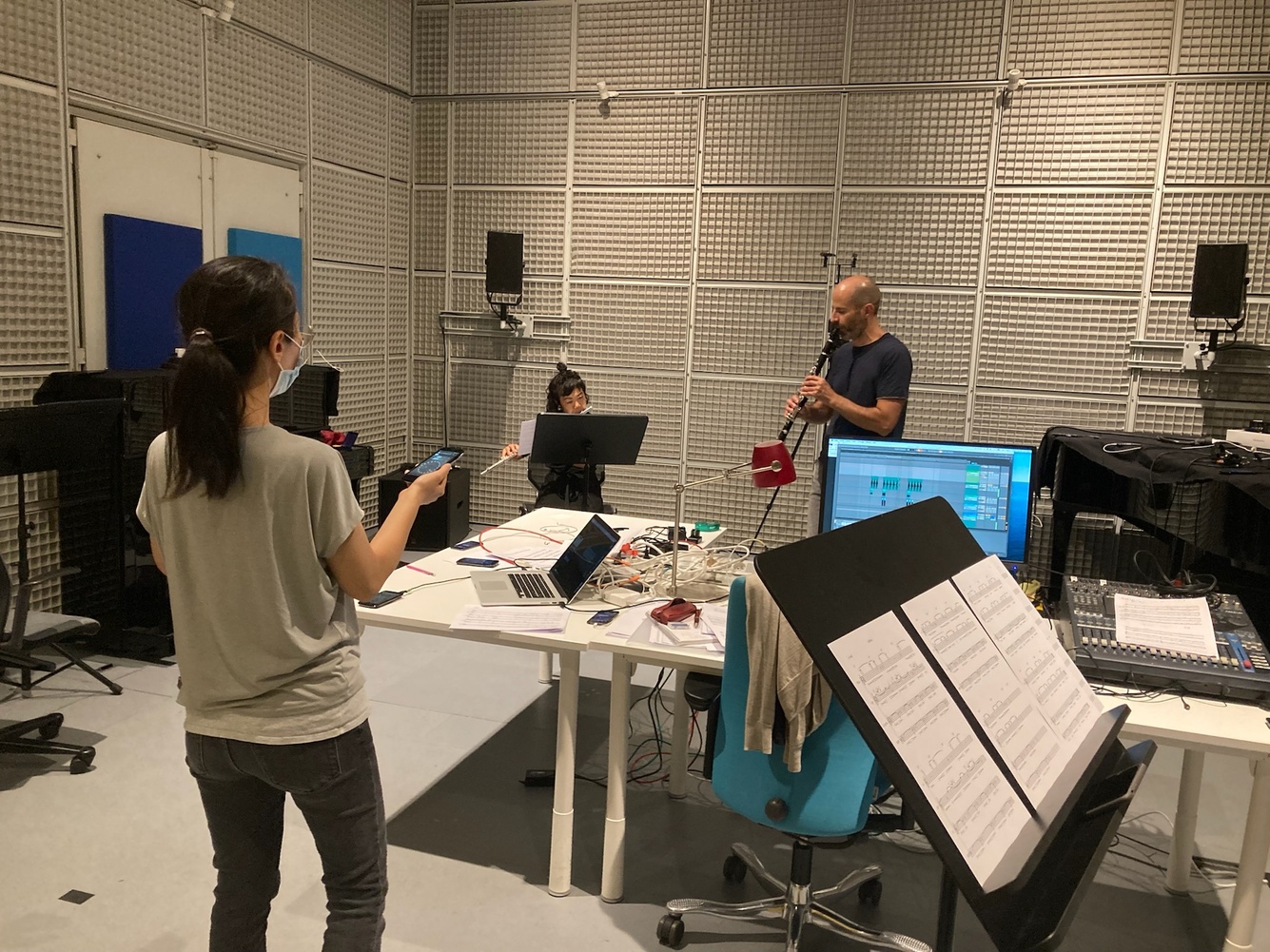
L'équipe du projet Astérismes dans les studios de l'Ircam
Pour l’instant, aucune solution satisfaisante n’a été trouvée pour mesurer la latence. Comme pour l’orchestre sans chef, le risque est donc grand de sombrer dans la cacophonie. Ne pas connaître la latence oblige la compositrice à proscrire toute écriture rythmique trop fine ou ciselée. « Ça devient une part d’aléatoire que j’accepte pour que la musique existe, dit-elle. Je peux toutefois la mettre à profit. Quand je compose des motifs rythmiques, je tiens compte (voire j’anticipe) d’éventuels effets d’écho. Quand le public est bien réparti dans l’espace, ça donne le sentiment d’une forme de réverbération. Pour certaines figures rythmiques, je peux aussi réduire le nombre de téléphones impliqués, et je peux évidemment composer des musiques un peu flottantes. »
To stream or not to stream
Autre contingence du dispositif : impossible pour l’instant de « streamer » les sons à tous les terminaux du public – ce qui poserait sans doute, du reste, d’autres problèmes de déconnexion intempestive ou de lenteur de téléchargement. La solution retenue à l’heure actuelle est d’envoyer les sons par paquets (dont la taille est d’ailleurs limitée à cinq à dix minutes, encore par des contraintes logicielles), pour les déclencher en temps voulu.
« Cela représente une grosse charge mentale pour le musicien, dit Jean-Philippe Lambert, mais nous travaillons actuellement à un nouveau système, avec Soundworks, le système sous-jacent développé par l’équipe ISMM sur lequel on s’appuie, qui permettrait de télécharger du son perpétuellement. Mais je suis certain que cela impliquera d’autres contraintes compositionnelles ! »
Autres contraintes d’importance : le timbre et le volume. La bande passante des téléphones (en termes sonores, s’entend) est assez restreinte. Les graves, notamment, ne passent pas. « Il faut trouver des solutions pour que ça sonne quand même, dit Aki Ito, on peut jouer sur l’accumulation, ou sur l’intégration au dispositif de petits haut-parleurs supplémentaires – ce qui peut délimiter l’espace. » Un avantage – ou un inconvénient. Comme on voudra. Ça dépend de la direction musicale choisie !![]()
[1] Rappelons qu’« Astérismes » utilise pour son déploiement les outils web inclus dans les navigateurs internet des smartphones.



